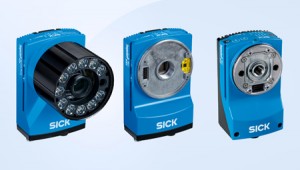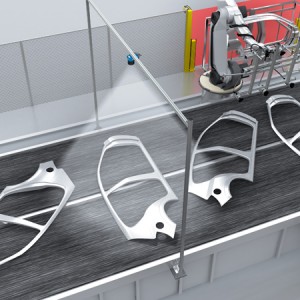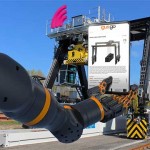Sick launches robot guidance for part localisation
 Sick has launched 2D and 3D vision-guided part localisation systems for easy and quick set-up of robot picking from a belt, or from a bin or stillage. Suitable for both cobots and conventional industrial robots, the Sick PLOC2D and PLB 520 have been developed specifically to facilitate affordable, or entry-level automation and for use in handling smaller parts and components.
Sick has launched 2D and 3D vision-guided part localisation systems for easy and quick set-up of robot picking from a belt, or from a bin or stillage. Suitable for both cobots and conventional industrial robots, the Sick PLOC2D and PLB 520 have been developed specifically to facilitate affordable, or entry-level automation and for use in handling smaller parts and components.
The Sick PLOC2D is an easy set-up vision system for 2D localisation of parts, products or packages to be picked from a static workstation, moving belt, or feeder system. The Sick PLB 520 uses a stereoscopic vision camera to enable 3D vision-guided bin picking applications of much smaller objects than was previously possible.
Both systems combine high-performance image processing hardware with a powerful Sick-developed algorithm to deliver ‘out of the box’ integration with pick and place robots. They have been developed to be directly compatible and simple to integrate with most leading industrial robot systems, including cobots such as Universal Robots.
Both the PLOC2D and the PLB 520 can be rapidly and easily connected directly to the robot control without programming skills or training and are ready to use almost immediately.
“The PLOC2D and PLB 520 are vision solutions to facilitate two of the most common robot tasks,” explains Neil Sandhu, national product manager for imaging, measurement and ranging at Sick UK. “Especially when combined with a cobot system, they provide new opportunities for production teams to replace repetitive or physically-demanding manual tasks with a more affordable robotic solution that is straightforward to set up.”
The PLOC2D sensor enables engineers and integrators to provide continuous picking of components and parts from a static workstation, moving belt or bowl feeder. PLOC2D supports single and multiple detection of parts and can identify one specific part type out of multiple types taught to the system.
The PLOC2D is therefore well suited to handling a variety of small parts. The pre-calibrated version with a 2 x 2m field of view can be also used for the high-precision localisation of large sheet metal stampings in press line automation, for example, in the automotive industry.
The PLB 520 is based on Sick’s existing PLB (Part Localisation for Bin picking) 3D robot-guidance system for picking randomly-arranged parts or products used with larger scale industrial robots. The need to pick up components that have been delivered to the factory in a container, bin or stillage and transfer them onto a conveyor belt for onward processing is a very common task.
 Integrated with a high-performance stereo vision camera, the PLB 520 will reliably identify and locate randomly-arrayed smaller objects in more confined containers than was previously possible. “Previously, most 3D part localisation systems were designed for larger scale applications,” explains Sandhu. “Now typical tasks like picking specific small parts like bolts from a deep mixed parts bin and placing them on a conveyor or selecting part-completed items and placing on a press or machining centre have become more feasible for smaller operations, like machining or assembly sub-contractors.”
Integrated with a high-performance stereo vision camera, the PLB 520 will reliably identify and locate randomly-arrayed smaller objects in more confined containers than was previously possible. “Previously, most 3D part localisation systems were designed for larger scale applications,” explains Sandhu. “Now typical tasks like picking specific small parts like bolts from a deep mixed parts bin and placing them on a conveyor or selecting part-completed items and placing on a press or machining centre have become more feasible for smaller operations, like machining or assembly sub-contractors.”
The PLOC2D comprises a powerful 2D imaging system based on the Inspector P vision sensor with an IP65 housing, which connects directly to the robot controller or PLC. The PLOC2D is supplied ready to use from the box in two versions, FIX with a fixed two by two metre field of view, and FLEX with a choice of four lenses and different optical resolutions to meet the application requirements.
The PLOC2D EasyTeach function matches taught-in shapes against the object shape measured down to a 0.5 pixel resolution in two axis, with a rotational measurement to 0.1o, providing a measurement in millimetres in a second. The approved shape and its location in the field of view is output to the robot controller to guide picking.
The PLB 520 comprises twin 1.3Mpixel resolution cameras, with central high power blue LED illumination for good rendition of a wide range of object finishes and allows specification of lens focal lengths to meet the application requirements for optimal image resolution.
The simple PLB 520 teach-in procedure uses uploaded CAD models of parts, together with a number of identified gripper positions, to enable the algorithm to locate the part in any orientation and select the most appropriate gripper position to pick up the part.
With installed software and an SD card, both systems have an easy-to-use interface which is compatible with webserver, Ethernet TCP/IP robot- and PLC interfaces, allowing site or remote configuration. Common communications platforms such as Sick’s 4DPro which incorporates standard protocols, facilitate easy integration of different devices and real time communication with a factory network.
“These solutions are the first for Sick, using its new AppSpace software development platform, to deliver easy to use vision guided part localisation for robotics,” says Sandhu. “They open up new applications for robotics so production engineers and machine designers alike can use cobots flexibly for different uses across a production facility, and even test out different automated processes. This sort of robotics is often not a high-speed substitute for manual picking but replaces a human’s repetitive and mundane task with a safer, high consistency alternative.”
Visit the Sick website for more information















